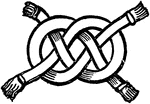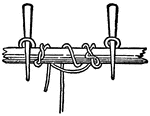
Knots
Simple knot. Note: the loop of a knot is called the "bright." The "standing part" of the rope is the…

Knots
Figure eight knot. Note: the loop of a knot is called the "bright." The "standing part" of the rope…

Knots
Common sheet bend connects two ropes. Note: the loop of a knot is called the "bright." The "standing…

Knots
Common bowline. Note: the loop of a knot is called the "bright." The "standing part" of the rope is…

Knots
Reef knot or square knot. Note: the loop of a knot is called the "bright." The "standing part" of the…

Knots
Carrick bend joins two ropes. Note: the loop of a knot is called the bright. The standing part of the…

Knots
Flemish loop. Note: the loop of a knot is called the "bright." The "standing part" of the rope is the…

Knots
Chain knot and toggle. The toggle is pulled to tighten up all the loops. Note: the loop of a knot is…

Knots
Sheepshank. Note: the loop of a knot is called the "bright." The "standing part" of the rope is the…
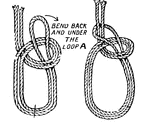
Knots
Bowline on a bight show in two stages. Note: the loop of a knot is called the "bright." The "standing…

Knots and Splices
"Knots and splices include all the various methods of tying, fastening, and joining ropes or cords.…
Knots and Splices
"Knots and splices include all the various methods of tying, fastening, and joining ropes or cords.…
Knots and Splices
"Knots and splices include all the various methods of tying, fastening, and joining ropes or cords.…
Knots and Splices
"Knots and splices include all the various methods of tying, fastening, and joining ropes or cords.…

Knots and Splices
"Knots and splices include all the various methods of tying, fastening, and joining ropes or cords.…

Knots and Splices
"Knots and splices include all the various methods of tying, fastening, and joining ropes or cords.…
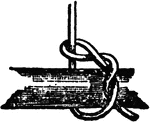
Knots and Splices
"Knots and splices include all the various methods of tying, fastening, and joining ropes or cords.…
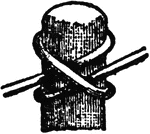
Knots and Splices
"Knots and splices include all the various methods of tying, fastening, and joining ropes or cords.…

Knots and Splices
"Knots and splices include all the various methods of tying, fastening, and joining ropes or cords.…
Knots and Splices
"Knots and splices include all the various methods of tying, fastening, and joining ropes or cords.…
Knots and Splices
"Knots and splices include all the various methods of tying, fastening, and joining ropes or cords.…
Knots and Splices
"Knots and splices include all the various methods of tying, fastening, and joining ropes or cords.…

Knots and Splices
"Knots and splices include all the various methods of tying, fastening, and joining ropes or cords.…
Knots and Splices
"Knots and splices include all the various methods of tying, fastening, and joining ropes or cords.…
Knots and Splices
"Knots and splices include all the various methods of tying, fastening, and joining ropes or cords.…

Knots and Splices
"Knots and splices include all the various methods of tying, fastening, and joining ropes or cords.…

Knots and Splices
"Knots and splices include all the various methods of tying, fastening, and joining ropes or cords.…

Knots and Splices
"Knots and splices include all the various methods of tying, fastening, and joining ropes or cords.…

Knots and Splices
"Knots and splices include all the various methods of tying, fastening, and joining ropes or cords.…

Knots and Splices
"Knots and splices include all the various methods of tying, fastening, and joining ropes or cords.…

Rose Lashing
A kind of lashing or seizing employed in binding anything on a spar. So termed from the rose like form…
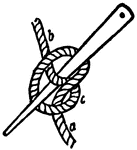
Marling-spike Hitch
"Marling-spike Hitch -- Lay the end a over c; fold the loop over on the standing part b; then pass the…
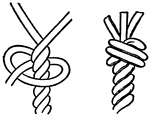
Matthew Walker
"Matthew Walker -- Unlay the end of a rope. Take the first strand round the rope, and through its own…

Midshipman's Hitch
"Midshipman's Hitch -- Take two round turns inside the bight, the same as a half-hitch repeated; stop…

Overhand Knot
An illustration of the overhand knot. "Used at the end of ropes to prevent their unreeving nd as the…

Black knot of the plum
Illustrations depicting a black knot of a plum. "1...represents the general appearance of the black-knot…

Black knot of the plum
"In answer to a communication of mine, Professor C. H. Peck, botanist, of Albany new York, informs me…

Racking Seizing
"Racking Seizing -- A running eye having been spliced round one part of the rope, the ine is passed…

Rolling Hitch
"Rolling Hitch -- Two round turns are taken round a spar or large rope in the direction on which it…

Seizing
Two seizings, a class of knots used to bind two parts of the same rope or to another object.
Sheepshank
The sheepshank is "a kind of knot, hitch, or bend made on a rope to shorten it temporarily." -Whitney,…

Sheet Bend
"Sheet Bend -- Pass the end of one rope though the bight of another, round both parts of the other,…

Sheet Bend
To form a sheet bend, pass the end of one rope through the bight of another, round both parts of the…
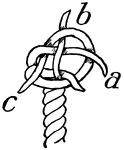
Single Wall and Crown
To make a crown on a single wall knot, take one of the ends, 'a', and lay it over the knot: lay 'b'…
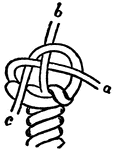
Single Wall Crowned
"Single Wall Crowned -- Form a single wall, and lay one of the ends, a, over the knot. Lay b over a,…
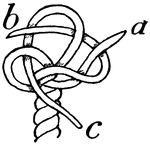
Single Wall Knot
Unlay the end of a rope, and with the strand 'a', form a bight. Take the next strand 'b' round the end…

Slings
"Slings -- This is simply the bight of a rope turned up over its own part; it is frequently made of…

Snotter
"A becket fitted round a boat's mast with an eye to hold the lower end of the sprit which is used to…
!["Studding-sail halyard bend -- Similar to the [Fisherman's Bend], except that the end is tucked under the first round turn; this is more snug. A magnus hitch has two round turns and one on the other side of the standing part with the end through the bight."](https://etc.usf.edu/clipart/58300/58374/58374_studdingsail_mth.gif)
Studding-sail Halyard Bend
"Studding-sail halyard bend -- Similar to the [Fisherman's Bend], except that the end is tucked under…
Leather Tassel
This leather tassel is a German Renaissance design found on a lady's bag. It is a simple knot to keep…
Modern Tassel
The modern tassel consists of a tuft of threads or cords hanging straight down from a core of wood,…
Modern Tassel
The modern tassel consists of a tuft of threads or cords hanging straight down from a core of wood,…
Modern Tassel
The modern tassel consists of a tuft of threads or cords hanging straight down from a core of wood,…
Modern Tassel
The modern tassel consists of a tuft of threads or cords hanging straight down from a core of wood,…
Old Standard Tassel
The old standard tassel consists of a tuft of threads or cords hanging straight down from a core of…
